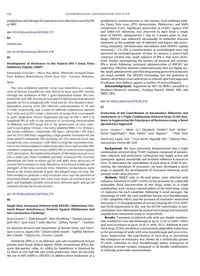Table Of ContentA34
23rd ICAR Abstract Issue / Antiviral Research 86 (2010) A1–A78
prophylaxis and therapy of respiratory virus infections cause by IAV
or HRV.
doi:10.1016/j.antiviral.2010.02.373
64
Withdrawn
doi:10.1016/j.antiviral.2010.02.374
65
Development of Resistance to the Natural HIV-1 Entry Virus
Inhibitory Peptide (VIRIP)
Emmanuel Gonzalez ∗, Maria Pau Mena, Mercedes Armand-Ugon,
Ester Ballana, Bonaventura Clotet, Jose Esté
IrsiCaixa, Badalona,
Spain
The virus inhibitory peptide (virip) was identified as a compo-
nent of human hemofiltrate and shown to have anti-HIV activity
through the inhibition of HIV-1 gp41-dependent fusion. We con-
firmed the anti-HIV activity of virip and the optimized virip-derived
peptide vir353 in lymphoid cells. Virip and vir-353 showed a dose-
dependent activity with 50% effective concentrations of 16 and
0.7 mM respectively and a time of addition experiment showed
that virip and vir353 target a time/site of action that corresponds
to gp41-dependent fusion. Sequential passage of HIV-1 NL4-3 in
lymphoid MT-4 cells in the presence of increasing concentration
of different anti-HIV drugs led to the generations of virus resis-
tant to nevirapine (10 days), the entry inhibitor BMS-155 (30 days),
the fusion inhibitors, enfuvirtide (90 days), sifuvirtide (180 days)
and vir-353 (260 days) suggesting a high genetic resistance for the
virip-related compound. The resulting vir-353 resistant virus was
completely cross-resistant (>200-fold) to virip but remained sensi-
tive to the fusion inhibitors enfuvirtide and C34 as well as other HIV
inhibitors targeting virus entry (AMD3100) or reverse transcriptase
(AZT, nevirapine). Recombination of gp41 of the virip resistant virus
into a wild-type HxB2 backbone partially recovered the resistant
phenotype but both resistant gp120 and gp41 were necessary to
recover full resistance to virip. Mutations were found in both gp120
and gp41 of the virip-resistant virus. However, no mutations were
found in the fusion peptide of gp41 the alleged target of virip. The
time needed to generate a virip resistant virus and the position of
mutations found suggest that virip may target an essential part of
gp41 and highlight possible interactions between gp41 and gp120
required during the fusion process.
doi:10.1016/j.antiviral.2010.02.375
66
Single-dose Intranasal Delivery with DEF201 (Adenovirus Vec-
tored Mouse Interferon-�) Protects Against Phlebovirus and
Sars Coronavirus Challenge
Brian Gowen 1,∗, Dale Barnard 1, Min-Hui Wong 1, Deanna Larson 1,
Josh Wu 2, Jane Ennis 3, John Morrey 1, Jeffery Turner 3
1 Institute
for Antiviral Research and Department of Animal, Dairy, and Veteri-
nary Sciences, Logan, USA 2 Defence R&D Canada – Suffield, Medicine
Hat, Canada 3 Defyrus Inc., Toronto, Canada
Interferon (IFN)-� is an effective and safe recombinant human
protein with broad clinical appeal. While recombinant IFN-� has
great therapeutic value, its utility for biodefense is hindered by
its short in vivo half-life and costly production. Here we describe
the use of Ad5-mIFN-� (DEF201) to address these limitations as a
prophylactic countermeasure in two murine viral challenge mod-
els, Punta Toro virus (PTV; Bunyaviridae, Phlebovirus) and SARS
coronavirus (CoV). Significant protection (p < 0.001) against PTV
and SARS-CoV infections was observed in mice from a single
dose of DEF201 administered 1 day to 3 weeks prior to chal-
lenge. DEF201 was delivered intranasally to stimulate mucosal
immunity at the probable site of infection and bypass any preex-
isting immunity. Intramuscular inoculation with DEF201 rapidly
increased (∼3 h) IFN-� concentrations in unchallenged mice and
persisted for extended periods of time. In contrast, a control Ad5
construct elicited only small amounts of IFN-� that were short-
lived. Studies investigating the kinetics of mucosal and systemic
IFN-� levels following intranasal administration of DEF201 are
underway. Effective medical countermeasures that are highly sta-
ble, easily administered, and elicit long lasting protective immunity
are much needed. The DEF201 technology has the potential to
address all of these issues and serves as a broad-spectrum approach
to enhance host defense against a number of viral pathogens.
Acknowledgement: Supported by N01-AI-30063 (awarded to
Southern Research Institute), Virology Branch, NIAID, NIH, and
DRDC CRA.
doi:10.1016/j.antiviral.2010.02.376
67
Evaluation of the Contribution of Amantadine, Ribavirin, and
Oseltamivir in a Triple Combination Antiviral Drug (TCAD) Reg-
imen to Suppressing the Emergence of Resistance using a Novel
Quantitative Approach
Justin
Hoopes 1,∗, Minh
Le 3, Elizabeth
Driebe 2, Erin
Kelley 2,
David Engelthaler 2, Amy Patick 3, Jack Nguyen 3
1 Utah State
University, Logan, USA
2 TGen North, Flagstaff, USA
3 Adamas Phar-
maceuticals, Emeryville, USA
Background: We have previously demonstrated that a triple
combination antiviral drug (TCAD) regimen comprised of amanta-
dine, ribavirin, and oseltamivir carboxylate was highly active and
synergistic against susceptible and resistant influenza A viruses in
vitro. To determine the contribution of each drug in TCAD to pre-
venting the emergence of resistance, we have developed a novel
assay to quantify the development of resistance following serial
passage under drug pressure.
Methods: MDCK cells in 96-well plates were infected with
influenza A/Hawaii/31/2007 (H1N1) in the presence of a clinically
achievable, fixed concentration of two drugs alone, or in triple
combination with varying concentrations of the third drug, using
12 replicates for each condition. Following 5 serial passages, the
percentage of wells for each condition having virus breakthrough
(>50% cytopathic effect) and the presence of resistance-associated
mutations (>1% total population of variants bearing the V27A, A30T,
and S31N substitution in M2, and the H274Y substitution in neu-
raminidase) was determined by neutral red staining and mismatch
amplification mutational analysis, respectively.
Results: Treatment of infected cells with any double combina-
tion resulted in virus breakthrough in up to 12 of 12 wells (100%)
and virus resistance in up to 10 of 11 wells (91%). Addition of each
third drug (TCAD) resulted in concentration dependent reductions
in the percentage of wells with virus breakthrough and virus resis-
tance. Importantly, the contribution of each drug in preventing
the emergence of resistance was shown by a statistically greater
(P < 0.05) reduction in virus breakthrough and/or emergence of
influenza resistant variants compared to all double combinations
at clinically achievable concentrations.

